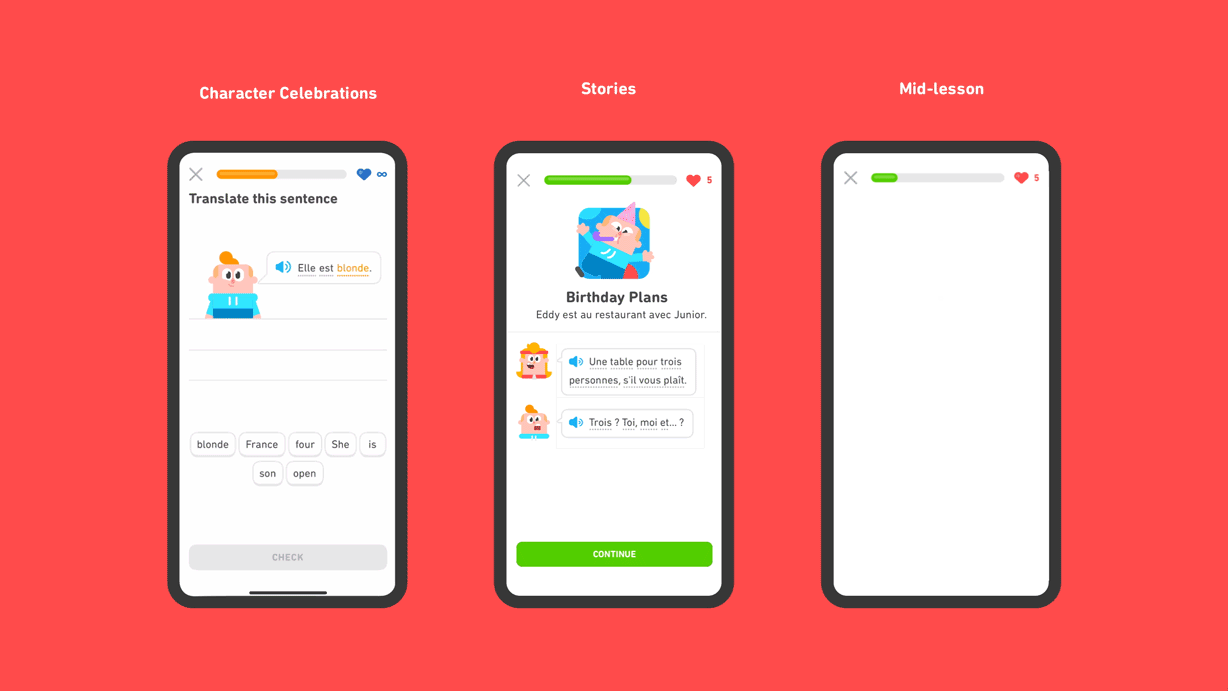/cdn.vox-cdn.com/uploads/chorus_image/image/67473339/project_world_cast_duolingo.0.png)
Language app Duolingo is unveiling a new cast of characters that it hopes will help users better learn new languages, even during the toughest lessons. The characters will act as guides within the app, cheering you on if you get an answer correct, or reacting in a disappointed (or sassy) way if you get one wrong. The nine characters of Duolingo Project World all have unique personalities, and serve as guides to make a new language feel more familiar.
“Obviously Duolingo is a very gamified language learning app,” says Duolingo art director Greg Hartman. “We took a lot of cues from other games, and I think you realize how motivating characters can be; when you remove the main character you have an emotional attachment to you’ll probably play that game less. We wanted to establish some emotional connection, and have characters that encourage users, by giving them positive reinforcement.”

Learning a language can be a challenging journey that takes a lot of mental energy, Hartman notes; you’re learning things like how to order food in Spanish, phrases that would be useful to communicate with other speakers, but maybe not the most scintillating conversation material. “So the question was: How you make these everyday scenarios fun?”
Keeping the Duo Design
In designing the characters that inhabit Duolingo World, Hartman says the team wanted to keep the same design elements of their mascot owl Duo, with his large eyes, simple body shape, and detached feet. With most cartoon characters, the design is informed by the character’s personality— triangles are dynamic, squares are solid, and circles are fun, for example. But the characters in Duolingo don’t really have story arcs, they’re only there to support the user. Hartman says they decided to let the design drive the characters’ personalities. So a girl with purple hair and lots of sharp angles became an emo

character named Lily; a round fellow with a beard is kind-hearted Vikram; and a blocky child character with a flourish of red hair became energetic Junior. They went through many shapes and iterations before arriving at their final nine designs, Hartman adds.
They also decided that in order for the experience to feel authentically immersive, they’d have to add voices, rather than relying on their default male or female voices. They hired a voice actor for each character, and worked with Microsoft to create custom text-to-speech fonts. “It brings more personality to the app, and if you’re not hearing the same voice all the time, it helps train our learners’ ears,” Hartman said.
Duolingo will be releasing the individual characters’ voices in the coming months.
Finding universal names
Choosing the names proved a bigger challenge than Hartman was expecting. They needed names that sounded the same across languages, so that ruled out some early ideas, including “Jun” for one character because in Spanish it would be pronounced “Hoon.” And they renamed one character when they realized that in French “Pete” can sound like the word for “fart.”
Hartman also says the team wanted to make sure they weren’t choosing names that might translate into something offensive in another language: “We checked each name in every language we teach,” he says. “That was a huge part of the development of the characters.” He adds that having a diverse workforce proved valuable: “All I had to do was go to a member of our team, and say ‘tell me where we’ve gotten it wrong’ and people were kind enough to help guide us.”
The last big redesign at Duolingo happened in 2018, when the company changed Duo’s look and gave him more expressions (if you’re not guilted into finishing your French lesson by a weepy green owl, I can’t help you), and redesigned the rest of the app to reflect his newer look.
:no_upscale()/cdn.vox-cdn.com/uploads/chorus_asset/file/13621832/3_the_many_faces_of_duo.png)
There are no plans to get rid of Duo, Hartman says; Duolingo is Duo’s world and these other characters live in it. But, he adds, they decided not to design the new characters as other animals, because it didn’t quite feel right for what they were trying to accomplish. “Language is so deeply rooted in human culture, and it seemed weird to add a cast of characters not from our world,” he said.
Fan Art Fridays
Duolingo started rolling out the new characters to appear in lessons in the app earlier this year, and have since been adding them to other features within the app as well. For instance, they began appearing in Duolingo Stories in July, and earlier this month, showed up in mid-lesson animations to cheer learners on.
Then a funny thing happened: Fan art versions of the characters started showing up on social media. So the company started a Fan Art Friday contest to encourage people to send in their art to be featured in Duolingo social posts.
The characters will officially roll out today at Duolingo’s annual Duocon conference. They’ll be available in Duolingo courses in which both languages are one of Spanish, French, German, English, or Portuguese, with plans to eventually add them to other language courses in the app.
Hartman says Duolingo thinks of gamifying language learning as a way to make a sometimes difficult —but ultimately rewarding— process more enjoyable, much in the way sports can make physical exercise seem like less of a grind. “It’s sometimes hard to get up and just run around your yard, but once you introduce a ball and healthy competition, you think less about how physically hard it is and more about the ball and the goal,” he said. “Duolingo wants to introduce a ‘mental ball’ to keep learners motivated.”
"how" - Google News
September 26, 2020 at 09:00PM
https://ift.tt/30cQmQq
How Duolingo designed the new characters for its Project World - The Verge
"how" - Google News
https://ift.tt/2MfXd3I
https://ift.tt/3d8uZUG
Bagikan Berita Ini
















0 Response to "How Duolingo designed the new characters for its Project World - The Verge"
Post a Comment